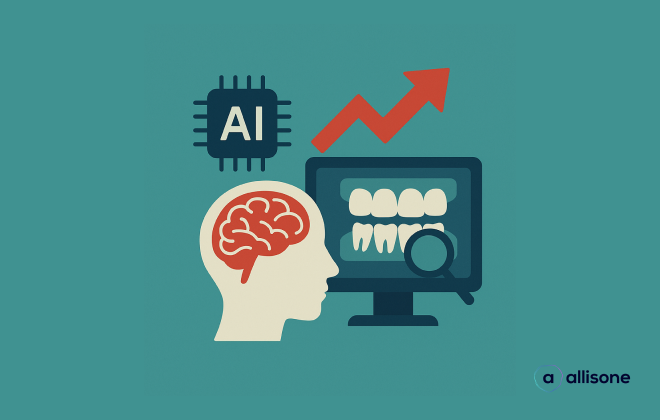
Being a dental surgeon can be an incredibly rewarding career, but it also comes with a unique set of challenges that can lead to burnout. Indeed, when dentists commit to a life of serving the health and well-being of others, it can take its toll as it can be difficult to maintain a work-life balance in the face of an ever-growing list of patient needs and expectations. In addition to this, they have to work long hours in their second role as a business owner: administrative management, human resources, organizations and obligations, ... Burnout among dentists is becoming more and more common. Understanding this phenomenon and knowing how to identify and prevent it is imperative in our profession. So what is burnout, how can dentists prevent it, and how can technology intervene? Let's take a look.
What is the phenomenon of professional exhaustion / Burnout?
Burnout is a state of chronic stress that leads to physical and emotional exhaustion, cynicism, detachment from work activities and a reduced sense of accomplishment. It is a process that takes hold over time. It affects people in all kinds of professions, but is particularly common among people working in the health care field.
Burnout can be the result of different issues:
- Workload in terms of intensity and duration: Overload, heavy and complex organization, continuous pressure, long working day, ...
- The emotional burden: dealing with serious cases and being confronted with the psychological suffering of patients, managing anxiety, ...
- Obligations, standards, laws, tariffs that prevent autonomy and choices for one's practice or patients.
- Insecurity about the financial evolution of the practice and the expenses: the fear of not being able to run the practice, the family and social stigma because of the risks involved.
For the dental profession, these include heavy workloads, constantly changing technologies that must be adapted to, time spent on paperwork and administrative tasks, the pressure of patient expectations and lack of work-life balance. In addition, dentists are often required to be available for patients in emergency situations, which can add an additional layer of stress.
How does burn-out set in?
What are the previous phases:
Burn-out is an insidious syndrome that sets in slowly and generally in 5 phases: the honeymoon phase, the disillusionment phase, the resistance phase, the gradual abandonment phase and, finally, the implosion that triggers the burnout.
In the honeymoon phase, individuals may have a sense of enthusiasm, excitement and energy towards their work. This is often accompanied by a sense of accomplishment and satisfaction when they experience their first successes in their role.
The disillusionment phase occurs when the individual begins to feel overwhelmed by the demands of the job. Tasks may become more difficult or tedious, resulting in a sense of boredom or stagnation. This may manifest itself in more negative emotions such as frustration, resentment and cynicism.
In the resistance phase, individuals may try to combat the difficult feelings by increasing their efforts and becoming more committed to their work. They may invest more time or energy in their work in order to regain a sense of control. However, this often leads to increased levels of stress and frustration.
The phase of gradual abandonment is the fourth stage in which individuals may begin to accept that their efforts are not making a significant difference and may have difficulty managing their emotions. They may begin to detach emotionally from the work and disengage from the tasks.
The fifth and final stage before burnout is the exhaustion phase. At this stage, individuals may experience feelings of exhaustion, apathy and hopelessness. They may withdraw completely from their work, often feeling overwhelmed and unable to cope.
These stages are not necessarily experienced in a linear fashion and can vary considerably depending on an individual's situation or work environment. It is important to recognize the signs of pre-burnout in order to address and manage them before they lead to burnout.
What are the warning signs to watch for?
The pre-exhaustion phase can cause a multitude of symptoms to be monitored:
Physical: Physical symptoms of pre-burnout can include headaches, muscle tension, digestive problems, chest pain and heart palpitations. In the most severe cases, people may experience extreme exhaustion and a strong desire to avoid physical activity. In addition, they may have difficulty falling or staying asleep due to racing thoughts or persistent worries about their situation. When fatigue sets in, it can lead to poor posture, back pain and other musculoskeletal pain.
Behavior: People in the pre-burnout phase may turn to unhealthy coping strategies such as substance abuse, avoidance behaviors and self-destructive habits. They may become more irritable with others, and may easily give in to temper tantrums. To cope with stress, they may also engage in procrastination or perfectionism.
Cognitive: Cognitive symptoms may include difficulty concentrating, poor memory, indecisiveness and an increased tendency to make mistakes. People in the pre-burnout phase may also feel mentally "foggy" or disconnected from their work and responsibilities.
Emotional: Emotional symptoms are common during the pre-burnout phase and include feelings of anxiety, depression, hopelessness and helplessness. People in this phase may also have difficulty making decisions, experience a lack of motivation or ambition, and have negative thoughts about their own performance.
Prevent burnout:
The key to preventing burnout is to identify the warning signs early so you can take action before it becomes too overwhelming. If any of these signs sound familiar, there are several steps you can take to combat burnout:
- Listen to your body's needs, rest, recharge your batteries, make time for physical activity, take a vacation to get some distance. Set clear limits with your work to respect your private life and discipline yourself to respect them.
- Recognize your limits and define what is not acceptable to you. Identify all the tasks that complicate or pose difficulties on a daily basis in order to outsource, delegate or automate them.
- Talk (!) with your colleagues, colleagues, relatives or health professionals to get support in managing this syndrome.
- Be aware of colleagues and fellow workers who may be in a similar situation.
It is important to remember that it is possible to have a satisfying and fulfilling career as a dentist, as long as you spend time preventing and treating the negative effects of burnout.
Burnout is a very real problem for many dentists today. By understanding the causes of burnout and learning to recognize the warning signs, dentists can take proactive steps to avoid it in their own lives. Taking regular breaks throughout the day, establishing work-life boundaries, getting a good night's sleep each night and exercising regularly are all key to preventing dental burnout - so make sure you take care of yourself! With the right strategies in place, burnout doesn't have to be inevitable!
Tip: You can also adopt technologies to help you with your daily tasks!
Technology can be a powerful tool to help prevent burnout. By leveraging elements such as automation, communication and online resources, technology can help reduce stress and manage workloads more effectively. Indeed, automation tools can help streamline operations and free up time for employees to focus on important tasks, while reducing the burden of constantly switching between tasks or managing mundane tasks. Communication tools can help keep teams connected and create a space for healthy dialogue, allowing colleagues to share challenges and provide support. Finally, online resources such as productivity apps, organizational software and time management tools can help employees better manage their workload and stay organized. By using technology in this way, organizations can have a substantial impact on employee productivity and comfort.
An application such asAllisone can facilitate your teaching work in the chair, automate certain administrative and time-consuming tasks, facilitate the transmission of information within the practice and give more autonomy to your dental assistants when faced with patients' questions.
At Allisone, our core business is patient communication but Allisone has also been designed to simplify the daily life of practitioners, reduce the workload while improving the acceptance rate of estimates. If you wish to automate certain tasks in your practice, discover Allisone by booking a 20-minute demonstration: https://calendly.com/decouvrir-allisone/demo-allisone?month=2023-02
Articles en lien
Lorem ipsum dolor sit amet, consectetur adipiscing elit.

New standard: Safety and traceability of implants








